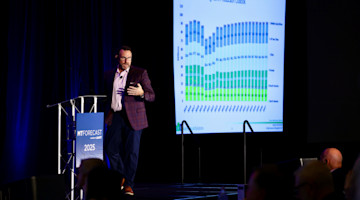At the Austin Regional Manufacturers Association (ARMA) Annual Meeting, I sat down with trade lawyer and former (USTR) counsel Patrick Childress for a keynote fireside chat on U.S. trade policy and tariffs.
The room was full of small and mid-sized manufacturers — and their suppliers of machine tools, automation, and software — trying to make sense of a fast-changing trade environment. AMT brought to the conversation the voice of our members: companies telling us that tariffs are raising costs, disrupting sourcing, and creating what we’ve started calling “tariff fatigue.”
AMT’s position isn’t about being for or against tariffs in principle. It’s about making sure trade policy is predictable, transparent, and genuinely strengthens U.S. manufacturing rather than weakening it.
Why the Landscape Shifted
Childress reminded the audience that today’s tariff policy isn’t random. Both the Trump and Biden administrations share the same strategic goals: rebuild U.S. industrial capacity, create jobs, and reduce trade deficits.
Where they diverge is in execution:
Biden leaned on “carrots.” Tax credits, grants, and alliance-building with traditional partners.
Trump 2.0 has gone all-in on “sticks.” Broad tariffs imposed quickly, often without exemptions or clear timelines.
2025 was the year of tariff imposition; 2026 will be the year of tariff enforcement.
Customs and Border Protection (CBP) is receiving new funding; the Department of Justice (DOJ) has established a tariff fraud task force staffed with career prosecutors and lawyers pulled in from other agencies.
What Manufacturers Wanted to Know — and What They Heard
Will the Supreme Court finally end the tariffs? Probably not. The case now before the Court challenges tariffs imposed under the International Emergency Economic Powers Act (IEEPA). Childress advised:
Outcome is a coin flip (roughly 50/50 by legal analysts).
Even if IEEPA tariffs fall, other tools remain — the administration could quickly rebuild similar duties under Section 232 (national security) or Section 301 (unfair trade).
There may be refunds available if IEEPA duties are struck down, but the overall tariff burden may not be reduced for very long.
What’s happening with the new Section 232 investigation on robots and machinery?
This was brand-new even after the prep call. The U.S. Department of Commerce is asking if the U.S. needs a domestic base to produce the machines that build the future factory floor.
Key risk: Tariffs could hit highly specialized robots, CNCs, and automation gear that’s largely made outside the US in countries like Japan, Germany, Switzerland, etc.
Action: Companies should file comments during the 21-day window. Strong comments give specifics — model/part numbers (HTS codes), cost impact, defense or national-security relevance, and evidence that no U.S. alternative exists.
Strength in numbers: One lone comment may be ignored; a coalition of companies or a trade group filing together gets noticed.
Can I get exemptions or exclusions?
Not under the current administration. Childress was blunt:
Officials are “allergic” to the words exemption and exclusion; using them hurts your ask.
Instead, talk about “tariff relief” or “temporary relief” — framing it as giving the U.S. time to build domestic capacity.
Tailor every request to the administration’s stated priorities: jobs, manufacturing, trade balance.
Suppliers say they have clever ways to avoid tariffs — safe to try?
Almost never.
DOJ’s new task force means country-hopping or reclassifying products without solid legal footing can trigger investigation.
Foreign suppliers can disappear if things go wrong; U.S. companies can’t.
If you plan to change HTS codes or country of origin, get a formal written legal opinion from experienced U.S. customs counsel first.
USMCA Review — Why It Matters Now
Deadlines: Written comments due November 3; in-person hearings start November 17 in Washington.
Opportunity: Think creatively — you can propose changes that remove barriers or reduce costs for your sector.
Tactics: Use specific SKUs, cost/job data, and defense relevance. Seek alignment with peers (even competitors) and trade associations for visibility. USTR staff are small; volume and coordination help your issue rise to the top.
An Action Playbook for SMB Manufacturers
Childress offered clear, immediate steps for companies navigating this environment:
Build a “tariff file” Keep organized records now — entry summaries, duty payments, HTS codes with reasoning, and a map of your supply chain beyond just Tier 1. If refund or relief opportunities appear, you’ll be ready.
Seek relief the smart way Use terms like “temporary tariff relief” and tie your ask to the administration’s stated goals: supporting U.S. manufacturing and jobs. Submit through official dockets and, if possible, coordinate with peers or trade groups for greater weight.
Avoid bad advice Don’t rely on suppliers’ country-hopping or classification tricks. These can lead to DOJ investigations. Always consult experienced trade counsel before making customs changes.
Monitor policy signals Track regulations.gov, CBP Cargo Systems messages, and AMT policy alerts. Watch especially for:
The Section 232 robots/machinery comment period.
The USMCA review timeline and hearings.
Focus your bandwidth If you can only do a few things: engage now on the Section 232 probe, prepare a comment for the USMCA review, and stay aware of — but don’t bet your strategy on the Supreme Court case.
Bottom Line
Tariffs are now a permanent feature of the trade landscape, not a temporary shock. But manufacturers aren’t powerless: organized records, smart advocacy, and coordinated comments can reduce costs and shape future rules.




